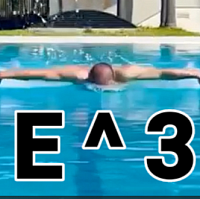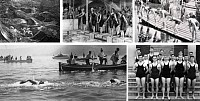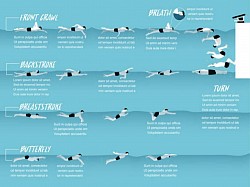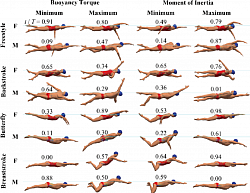Brief Summary about SWIMMING
History
Swimming, In recreation and sports, the propulsion of the body through water by combined arm and leg motions. Swimming is popular as an all-around fitness routine and as a competitive sport. It has been included in the modern Olympic Games since their inception in 1896. Events include freestyle (crawl-stroke) races at distances of 50, 100, 200, 400, 800, and 1,500 m; backstroke, breaststroke, and butterfly races at 100 and 200 m; individual medley races at 200 and 400 m; freestyle relays, 4 × 100 m and 4 × 200 m; and the medley relay, 4 × 100 m. Long-distance swimming competitions, usually of 15–37 mi (24–59 km), are generally held on lakes and inland waters.
STROKES
- The earliest strokes to be used were the sidestroke and the breaststroke. The sidestroke was originally used with both arms submerged. That practice was modified toward the end of the 19th century by bringing forward first one arm above the water, then the other, and then each in turn. The sidestroke was supplanted in competitive swimming by the crawl but is still used in lifesaving and recreational swimming. The body stays on its side and the arms propel alternately. The leg motion used in sidestroke is called the scissors kick, in which the legs open slowly, under leg backward, upper leg forward, both knees slightly bent, and toes pointed. The scissoring action of the legs coming smartly together after opening creates the forward propulsion of the kick. The breaststroke is believed to be the oldest of strokes and is much used in lifesaving and recreational swimming as well as in competitive swimming. The stroke is especially effective in rough water. As early as the end of the 17th century, the stroke was described as consisting of a wide pull of the arms combined with a symmetrical action of the legs and simulating the movement of a swimming frog, hence the usual term frog kick. The stroke is performed lying face down in the water, the arms always remaining underwater. The early breaststroke featured a momentary glide at the completion of the frog kick. Later the competitive breaststroke eliminated the glide. In the old breaststroke, breath was taken in at the beginning of the arm stroke, but in the later style, breath was taken in near the end of the arm pull.
- The butterfly stroke, used only in competition, differs from the breaststroke in arm action. In the butterfly the arms are brought forward above the water. The stroke was brought to the attention of U.S. officials in 1933 during a race involving Henry Myers, who used the stroke. He insisted that his stroke conformed to the rules of breaststroke as then defined. After a period of controversy, the butterfly was recognized as a distinct competitive stroke in 1953. The frog kick originally used was abandoned for a fishtail (dolphin) kick, depending only on up-and-down movement of the legs. Later swimmers used two dolphin kicks to one arm pull. Breathing is done in sprint competition by raising the head every second or third stroke.
- The backstroke began to develop early in the 20th century. In that stroke, the swimmer’s body position is supine, the body being held as flat and streamlined as possible. The arms reach alternately above the head and enter the water directly in line with the shoulders, palm outward with the little finger entering the water first. The arm is pulled back to the thigh. There is a slight body roll. The kick was originally the frog kick, but it subsequently involved up-and-down leg movements as in the crawl. The backstroke is a competition stroke, but it is also used in recreational swimming as a rest from other strokes, frequently with minimum arm motion and only enough kick to maintain forward motion.
- The crawl, the stroke used in competitive freestyle swimming, has become the fastest of all strokes. It is also the almost unanimous choice of stroke for covering any considerable distance. The stroke was in use in the Pacific at the end of the 19th century and was taken up by the Australian swimmer Henry Wickham about 1893. The brothers Syd and Charles Cavill of Australia popularized the stroke in Europe in 1902 and in the United States in 1903. The crawl was like the old sidestroke in its arm action, but it had a fluttering up-and-down leg action performed twice for each arm stroke. Early American imitators added an extra pair of leg actions, and later as many as six kicks were used. The kicks also varied in kind. In the crawl, the body lies prone, flat on the surface of the water, with the legs kept slightly under the water. The arms move alternately, timed so that one will start pulling just before the other has finished its pull, thus making propulsion continuous. Breathing is done by turning the head to either side during recovery of the arm from that side. Since 1896 the crawl has been used in more races than any other stroke.





